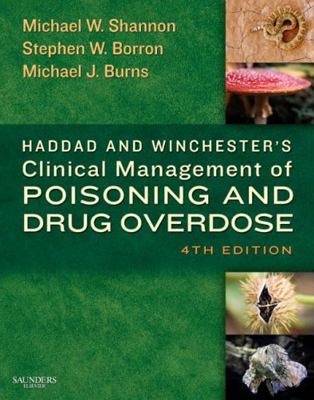The fourth edition of Haddad and Winchester’s Clinical Management of
Poisoning and Drug Overdose is the most current, authoritative, and
concise reference for information related to the clinical management
of children and adults whose health has been effected or potentially
effected by toxic agents, including drugs, environmental threats, and
natural toxins.
차 례
General Information
1. The Emergency Management of Poisoning
2. Pediatric Resuscitation and Fluid Management
3. Laboratory Diagnoses and Drug Screening
4. Principles of Pharmacology for the Clinician
5. Acid-Base, Fluid, and Electrolyte in Adults
6. Cardiac Disturbances
7. Management of Respiratory Complications in the Poisoned Patient
8. Clinical Neurotoxicity
9. Chemical Hepatic Injury
10. Active Methods for Detoxification
11. Renal Toxicity A. Acute Renal Toxicity B. Chronic Renal Toxicity
12. Gastrointestinal Effects of Poisoning
13. Hematologic Consequences of Poisoning
14. Toxic Injury to the Eye
15. Endocrine Agent Toxicity
16. Management Principles of Overdose in Pregnancy 17. Toxic
Emergencies in the Neonate
18. Introduction to Geriatric Toxicology
19. Psychiatric Evaluation of the Suicidal Patient
20. Prevention of Childhood Poisonings
21. Drug-Drug Interactions
22. Disaster Management of Massive Toxic Exposure
Specific Poisons
23. North American Venomous Snakebite
24. Poisonous Arthropods A. Spiders B. Scorpions C. Stinging Insects
25. Mushrooms
26. Poisonous Plants
27. Toxic Marine Life
28. Botulism and Food Poisoning
29. Radiation Poisoning
30. Environmental Poisoning
Centrally Active Agents
31. Tricyclic Antidepressants and Selective Serotonin Reuptake
Inhibitors
32. Monoamine Oxidase Inhibitors and the Serotonin Syndrome
33. Lithium
34. Ethanol
35. Methanol, Isopropyl Alcohol, Higher Alcohols, Ethylene Glycol,
Cellosolves, Acetone, and Oxalate 36. Opiates and Narcotics
37. Barbiturates
38. Marijuana 39. Cocaine
40. Phencyclidine
41. Amphetamines
42. Designer Drugs
43. Sedatives
44. Benzodiazepenes
45. The Antipsychotic Drugs
46. Anticholinergics and Antihistamines
47. Oral Hypoglycemic Agents
48. Anticonvulsants
Analgesics
49. Acetaminophen
50. Salicylate Toxicity
51. Nonsteroidal Anti-inflammatory Drugs and Colchicine
Antimicrobial and Chemotherapeutic Agents
52. Antibiotics and Anthelminthics A. Antibiotics B.
Antibiotic Toxicity C. Anthelminthics
53. Isoniazid
54. Chemotherapeutic Agents and Transplant Agents A. Chemotherapeutic
Agents B. Transplant Agents
Heavy Metal Agents and Inorganic Agents
55. Mercury
56. Iron
57. Lead
58. Arsenic and Arsine
59. The Toxicology of Other Heavy Metals
60. Bromine and Iodine Compounds
61. Hydrofluoric Acid
62. Alkali Injury A. Caustics B. The Miniature Battery Hazard
63. Acids and Antacids
64. Bleach, Soaps, Detergents, and Other Corrosives
Pesticides
65. That Organophosphates and Other Insecticides
66. Paraquat and the Bipyridyl Herbicides
67. Chlorophenoxy Herbicides and Dioxin Contamination; Other
Herbicides and Fungicides
68. Rodenticides
Inhalation Poisoning and Solvents
69. Smoke Inhalation
70. Carbon Monoxide Poisoning
71. Cyanide and Related Compounds
72. Hydrogen Sulfide
73. Petroleum Distillates and Turpentine
74. Industrial Toxicology
75. Chlorinated Hydrocarbons
76. Benzene and the Aromatic Hydrocarbons
77. Freon and Other Inhalants
78. Phenol and Related Agents
79. Phosgene and Phosphine
80. Chlorine
81. Methyl Bromide and Related Compounds
82. Ammonia, Nitrogen, Nitrogen Oxides, and Related Compounds
83. Tear Gas and Riot Control Agents
84. Volatile Substance Abuse
Cardiovascular and Hematologic Agents
85. Digitalis
86. Calcium Channel Blocker Poisoning
87. a-Adrenergic Blocker Toxicity
88. Nitroprusside, ACE Inhibitors, and Selected Antihypertensive
Agents
89. Clonidine and related Imidaz


